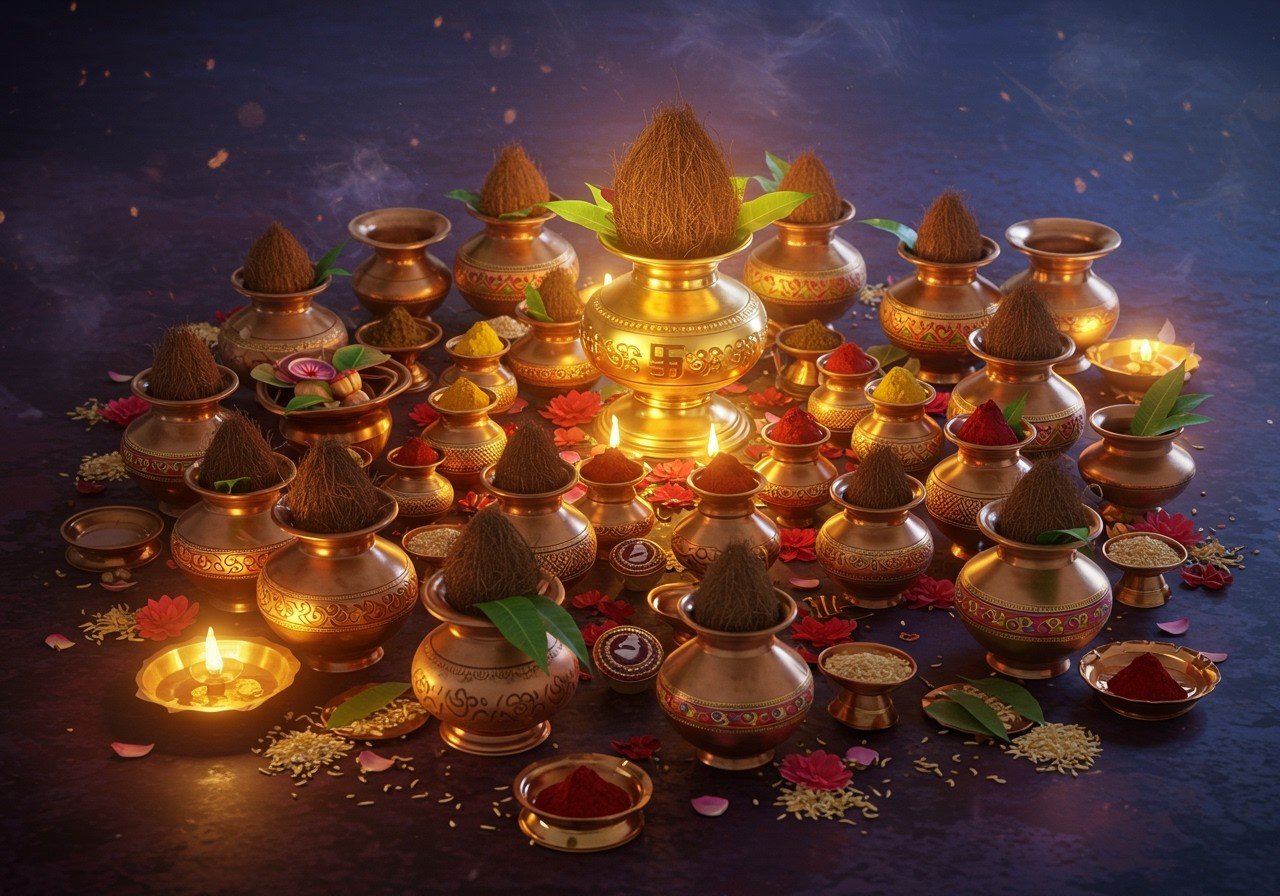
In Hindu culture, the Kalash, also known as the Purna-Kalasha, Purna-Kumbha, or Purna-Ghata, isn’t just a vessel; it’s a profound symbol of spirituality, abundance, prosperity, and purity. More than just a metal pot, typically crafted from brass, copper, silver, or even gold, it represents a sacred connection to the divine and our cultural heritage. The Kalash, with its large base and small mouth, often adorned with vibrant mango leaves and a coconut, is a vessel overflowing with spiritual energy, a beacon of hope and auspiciousness in our traditions.
Unveiling the Significance of the Kalash
Symbolism: The Kalash is deeply symbolic. It embodies deities like Ganesha, the remover of obstacles, Gauri, the goddess of household bounty, and Lakshmi, the goddess of prosperity. It’s a representation of abundance, wisdom, and the promise of immortality, believed to hold amrita, the elixir of life itself. It’s a tangible link to the divine, a reminder of the blessings that surround us.
A Divine Presence: The Kalash isn’t merely an object; it’s revered as a vessel of divine presence, holding the essence of the deity and radiating sacred energy during ceremonies. Its presence sanctifies the space, invoking a sense of reverence and devotion.
Ritualistic Importance: The Kalash plays a central role in Hindu rituals. It’s offered as a ceremonial gesture to deities and honored guests. Its presence graces shrines and buildings, radiating auspiciousness and blessings. From marriages to childbirth, the Kalash is worshipped, symbolizing the mother goddess or Devi. This reverence extends to Lord Vishnu in household rituals as well.
Components and Their Meanings: Every element of the Kalash carries deep meaning:
- The Pot: The pot itself represents the material world, a container of fertility, much like the earth and the womb, nurturing and sustaining life. Its wide base symbolizes Prithvi (Earth), the expanded center represents Ap (water), the neck represents Agni (fire), and the opening represents Vayu (air). It’s a microcosm of the universe, holding the elements of creation.
- Mango Leaves: The vibrant green mango leaves symbolize the joyous aspect of fertility, associated with Kamadeva, the god of love. They bring a sense of freshness and vitality to the Kalash, representing growth and new beginnings.
- Coconut: The coconut atop the Kalash embodies prosperity and power. The head of the coconut signifies the Sahasrara, or crown chakra, the seat of spiritual awakening. It’s a reminder of our connection to the divine consciousness.
- Water: The water within the Kalash signifies the divine energy that sustains all life. It represents the primordial waters from which the universe emerged, connecting us to the very source of creation. This sacred water is believed to purify and energize the surroundings.
Need pure water for your Kalash? Consider our Poojn 15 ml Fountain Pen Ink for Puja Purpose for adding sanctity to your rituals.
Ceremonial Uses: The Purna-Kalasha is an integral part of various Hindu ceremonies:
- Griha Pravesh (Housewarming): The Kalash welcomes prosperity and positive energy into a new home, ensuring the well-being of the family. It’s a blessing for a harmonious and joyful beginning.
- Child Naming Ceremonies: The Kalash invokes blessings for the newborn, symbolizing a life filled with abundance and good fortune.
- Havan (Fire Sacrifice): The Kalash is an essential part of havans, representing the divine presence and the offering of prayers.
- Vaastu Dosha Rectification: The Kalash helps balance energies and rectify Vaastu defects, creating a harmonious living environment.
- Daily Worship: The Kalash is often included in daily puja, invoking the blessings of the deities.
- Navratri and Diwali: During Navratri, the Kalash invokes Goddess Durga, while during Diwali, it welcomes Lakshmi, the goddess of wealth.
A Protective Barrier: Placed at the entrance of homes, temples, or sacred spaces, the Kalash acts as a symbolic guardian. It wards off negative influences and invites positive forces into the environment, creating a sacred and protected space. It’s a silent sentinel, safeguarding the sanctity of our homes and places of worship. Enhance the protection offered by a Kalash at your home’s entrance with this beautifully designed Fabric Coloured Hand-Printed Baran Dala Chalon available at poojn.in.
Poojn.in: Your Source for Authentic Kalash
At poojn.in, we understand the significance of the Kalash in Hindu traditions. We offer a wide selection of authentic Kalash, crafted with utmost care and reverence. Find the perfect Kalash for your needs, whether it’s a traditional brass Kalash for daily worship, a silver Kalash for special ceremonies, or even a clay Kalash for Navratri. We also offer a range of Kalash accessories, including coconuts, mango leaves, and kumkum. Check out our Kalash Kumkum-Roli by Drolia for a touch of tradition.
The Kalash is more than just a pot; it’s a powerful symbol deeply rooted in Hindu traditions. It represents the interconnectedness of humanity, nature, and the divine. By incorporating the Kalash into our rituals, we honor our heritage and invite blessings into our lives. Looking for a Kalash for your next puja? Visit poojn.in, India’s leading online store for puja samagri and other religious items. You can also enhance your havan with high-quality Hawan Samagri from our store.
Exploring the Different Types of Kalash
Kalash come in various forms, each with its own unique purpose in Hindu rituals. Understanding these variations helps us choose the most appropriate Kalash for different occasions.
- Traditional Brass Kalash: Known for its durability and aesthetic appeal, the brass Kalash is commonly used in household worship and temple ceremonies. Its golden hue symbolizes prosperity and auspiciousness. Consider this Pure Brass Lota Kalash for your puja needs.
- Silver Kalash: Representing purity and sanctity, the silver Kalash is often preferred for significant events like weddings, religious festivals, and important pujas. It adds a touch of elegance and reverence to the ceremony.
- Clay Kalash: An eco-friendly option, the clay Kalash is particularly used during Navratri for planting barley seeds, symbolizing growth and abundance. It connects us to the earth and represents the cycle of life.
- Modern Materials: Contemporary options like glass and stainless steel Kalash cater to modern aesthetics while still honoring traditional values. They offer a blend of practicality and style for those seeking a modern touch.
Choosing the right Kalash depends on the specific ritual and personal preferences. Each variation carries its unique significance, allowing devotees to select the most appropriate one for the occasion. Would you like to add an extra dimension to your Saraswati Puja? Check out our collection of special Khager Pens available at poojn.in. Seeking blessings from Maa Tara? This exquisite Pure Brass Maa Tara Murti might be just what you need for your altar.
Frequently Asked Questions
Many of us have questions about the Kalash, its uses, and its significance. Here are a few common queries:
What is a Kalash, and why is it important? A Kalash is a sacred vessel used in Hindu rituals, symbolizing abundance, wisdom, and immortality. It is crucial because it is believed to invite positive energy and blessings into our homes and lives.
What materials are Kalash made from? Kalash can be made from various materials, including copper, brass, silver, and clay, each holding its own significance in different rituals. The choice of material often reflects the specific deity being honored and the nature of the ceremony.
Are there different types of Kalash? Yes, there are different types, such as the Purna Kalash, Navagraha Kalash, and the Kalash used for Kalash Sthapana. Each type has a unique purpose and symbolism within Hindu rituals.
How is a Kalash used in rituals? In Hindu rituals, a Kalash is typically filled with water, adorned with mango leaves, and topped with a coconut. It is placed at the entrance of homes, near the deity, or in a designated sacred space to symbolize purity, prosperity, and divine presence. Learn more about sacred Hindu symbols.
Can a Kalash be reused? Yes, a Kalash can be reused for multiple rituals. However, it’s essential to cleanse and purify it before each use to maintain its sanctity and ensure that it remains a vessel for positive energy.
What is the meaning of the water inside? The water inside the Kalash is not ordinary water; it symbolizes the life-giving force, purity, and the primordial origins of the universe. It is considered sacred and is often sprinkled around during rituals to purify the environment.
Is there a specific direction to place the Kalash? Yes, ideally, the Kalash should be placed facing east or north, aligning with the flow of positive energies and invoking prosperity and blessings.
You can dive deeper into the world of Yantras and Yagyas through this informative beginner’s guide.
Can I buy a Kalash online? Absolutely! Many reputable online stores offer a wide variety of authentic and traditional Kalash, providing the convenience of choosing the perfect one from the comfort of your home. If you are intrigued by the spiritual aspects of rituals, you might find this article on alcohol in Hindu rituals insightful. Explore the mystical aura of the Kal Bhairav Temple in Ujjain through this captivating blog post.


